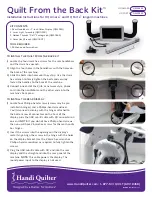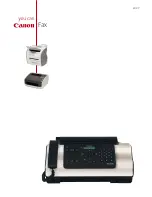
hole in the chain block and insert the small end if the pin in
the hole. Push the pin in by hand until it stops and then use a
hammer or slow acting press to drive the pin into position so
that the end of the pin is flush with the outside surface of the
hook body.
REMOVAL AND INSTALLATION OF
LOAD CHAIN
USE ONLY CM STAR (
#
) GRADE LOAD
CHAIN AND CM REPLACEMENT PARTS.
USE OF OTHER CHAIN AND PARTS MAY
BE DANGEROUS AND VOIDS FACTORY
WARRANTY.
NOTE: When installing load chain in Models E, H, R,
RR, E-2, H-2, R-2 and RR-2 by either of the
“starter chain” methods, two loose end connect-
ing links (627-743) must be used.
Hoist load chain can be installed by any one of several meth-
ods. The first method is recommended when replacing
severely worn load chain and requires disassembling the
hoist. Method 2 does not require hoist disassembly, whereas
Method 3 requires only partial disassembly.
Method #1
a) Disconnect hoist from power supply.
b) Remove back frame cover and disengage the limit
switch guide plate from the traveling nuts, see page
16 or 17.
L
L
!!
WARNING
Improper installation (reeving) of the load chain can result in a
dropped load.
TO AVOID INJURY:
Vertify use of proper size and type of hoist load chain for
specific hoist.
Install load chain properly as indicated below.
c) Detach loose end of load chain from hoist frame, see
Figure 7. Also on single reeved models, detach the
lower hook block from the load chain. On double
reeved models E, H, R, RR, E-2, H-2, R-2, and RR-2,
unfasten the dead end side of the load chain. On
triple reeved Models RT, RRT, RT-2 and RRT-2, detach
the load chain from the lower hook block.
d) Continue to disassemble the hoist and inspect the lift-
wheel, chain guides, motor housing and gear housing
which if worn or damaged could cause early failure of
the new chain. Parts can be easily identified by refer-
ring to pages 51 thru 85.
e) If the liftwheel pockets, in particular the ends, are
worn or scored excessively, replace the liftwheel. If
chain guides and housing are worn or cracked, these
parts should be replaced.
f) Reassemble hoist with the new load chain inserted
over the liftwheel. Position chain with the weld on
upstanding links away from liftwheel and leave only
one foot of chain hanging free on loose end side.
Make sure the last chain link is an upstanding link. On
double reeved models, make sure that the new load
chain has an even number of links. On triple reeved
models, make sure that the new chain has an odd
number of links. This will prevent twist in chain.
To simplify handling when reassembling the hoist, a
short undamaged piece of the old chain may be used
as a “starter chain”. Position this piece of chain in
exactly the same manner as explained above for the
“new chain”, and complete the reassembly of the
hoist.
g) Attach the loose end link to chain and connect it to
the hoist frame with the loose end screw, washer and
lockwasher, see Figure 7. B
BE
E S
SU
UR
RE
E T
TH
HE
ER
RE
E IIS
S N
NO
O
T
TW
WIIS
ST
T.
If a starter chain is used, the loose end link (two links
required for double reeved models) can serve as a
temporary coupling link to connect together the starter
chain in the hoist and the new load chain to be
installed. Then, under power, reeve the new load
chain through the liftwheel area, replacing the starter
chain in unit. Run enough chain through to attach
loose end link to hoist frame.
Caution: For double reeved models, be sure to
disconnect one of the loose end links from load
chain before attaching to hoist frame.
h) For single reeved models, attach the hook block to
load chain.
i)
For double reeved models, run the hoist
(UP) until
only 3 feet (.9 M) in chain remains on dead end side.
This will minmize the chance of introducing a twist
between hook block and hoist.
Allow the chain to hang free to remove twists.
Using a wire as a starter, insert the chain, flat link first,
into lower hook block (upstanding links will have weld
toward sheave) and pull through. Insert last link into
slot in dead end block making sure that no twist
exists in the reeving at any point.
Assemble dead end pin, washer and cotter pin as
shown in Figure 7.
j)
For triple reeved models, run the hoist
(UP) until only
4 feet (1.2 M) of chain remains on the dead end side.
This will minimize the chance of introducing a twist
between the hook block and hoist.
Allow the chain to hang free to remove twists.
Using a wire as a starter, insert the chain, upstanding
link first, into lower hook block (upstanding links will
49
L
L
!!
WARNING
Use of improper lower hook chain block pin as well as improp-
er installation of this pin can cause the pin to break and allow
the load to fall.
TO AVOID INJURY AND PROPERTY DAMAGE:
Use only CM supplied, special high strength lower hook chain
block pin to attach the chain to the lower hook block and
install the pin as directed above.
L
L
!!
WARNING
USE OF COMMERCIAL OR OTHER MANUFACTURERS’ CHAIN
AND PARTS TO REPAIR CM HOISTS MAY CAUSE LOAD
LOSS.
TO AVOID INJURY:
Use only CM supplied replacement load chain and parts. Chain
and parts may look alike, but CM chain and parts are made of
specific material or processed to achieve specific properties.
Содержание CM Hoist
Страница 28: ...24 WIRING DIAGRAMS MODELS A AA B C E F H 110 115 1 50 60 VOLT...
Страница 29: ...25 WIRING DIAGRAMS MODELS A AA B C E F H 220 230 1 50 60 VOLT...
Страница 30: ...26 WIRING DIAGRAMS MODELS A AA B C E F H 220 230 3 50 60 OR 380 415 460 3 50 60 VOLT...
Страница 31: ...27 WIRING DIAGRAMS MODELS A AA B C E F H 220 230 3 50 60 OR 380 415 460 3 50 60 VOLT CSA UNITS...
Страница 32: ...28 WIRING DIAGRAMS MODELS A 2 AA 2 B 2 C 2 E 2 F 2 H 2 220 230 3 50 60 VOLT...
Страница 33: ...29 WIRING DIAGRAMS MODELS A 2 AA 2 B 2 C 2 E 2 F 2 H 2 220 230 3 50 60 VOLT CSA UNITS...
Страница 34: ...30 WIRING DIAGRAMS MODELS A 2 AA 2 B 2 C 2 E 2 F 2 H 2 380 415 460 3 50 60 VOLT...
Страница 35: ...31 WIRING DIAGRAMS MODELS A 2 AA 2 B 2 C 2 E 2 F 2 H 2 380 415 460 3 50 60 VOLT CSA UNITS...
Страница 36: ...32 WIRING DIAGRAMS MODELS A AA B C E F H 550 575 3 50 60 VOLT...
Страница 37: ...33 WIRING DIAGRAMS MODELS A AA B C E F H 550 575 3 50 60 VOLT CSA UNITS...
Страница 38: ...34 WIRING DIAGRAMS MODELS A 2 AA 2 B 2 C 2 E 2 F 2 H 2 550 575 3 50 60 VOLT...
Страница 39: ...35 WIRING DIAGRAMS MODELS A 2 AA 2 B 2 C 2 E 2 F 2 H 2 550 575 3 50 60 VOLT CSA UNITS...
Страница 40: ...36 WIRING DIAGRAMS MODELS J L R RT 110 115 1 50 60 VOLT...
Страница 41: ...37 WIRING DIAGRAMS MODELS J L R RT 220 230 1 50 60 VOLT...
Страница 42: ...38 WIRING DIAGRAMS MODELS J JJ L LL R RR RT RRT 220 230 3 50 OR 380 415 460 3 50 60 VOLT...
Страница 43: ...39 WIRING DIAGRAMS MODELS J JJ L LL R RR RT RRT 220 230 3 50 60 OR 380 415 460 3 50 60 VOLT CSA UNITS...
Страница 44: ...40 WIRING DIAGRAMS MODELS J 2 JJ 2 L 2 LL 2 R 2 RR 2 RT 2 RRT 2 220 230 3 50 60 VOLT...
Страница 45: ...41 WIRING DIAGRAMS MODELS J 2 JJ 2 L 2 LL 2 R 2 RR 2 RT 2 RRT 2 220 230 3 50 50 VOLT CSA UNITS...
Страница 46: ...42 WIRING DIAGRAMS MODELS J 2 JJ 2 L 2 LL 2 R 2 RR 2 RT 2 RRT 2 380 415 460 3 50 60 VOLT...
Страница 47: ...43 WIRING DIAGRAMS MODELS J 2 JJ 2 L 2 LL 2 R 2 RR 2 RT 2 RRT 2 380 415 460 3 50 60 VOLT CSA UNITS...
Страница 48: ...44 WIRING DIAGRAMS MODELS J JJ L LL R RR RT RRT 550 575 3 50 60 VOLT...
Страница 49: ...45 WIRING DIAGRAMS MODELS J JJ L LL R RR RT RRT 550 575 3 50 60 VOLT CSA UNITS...
Страница 50: ...46 WIRING DIAGRAMS MODELS J 2 JJ 2 L 2 LL 2 R 2 RR 2 RT 2 RRT 2 550 575 3 50 60 VOLT...
Страница 51: ...47 WIRING DIAGRAMS MODELS J 2 JJ 2 L 2 LL 2 R 2 RR 2 RT 2 RRT 2 550 575 3 50 60 VOLT CSA UNITS...
Страница 57: ...53 Notes...
Страница 62: ...58 LODESTAR LOWER HOOK BLOCK ASSEMBLY...
Страница 89: ...85 NOTES...
Страница 93: ...89 NOTES...
















































